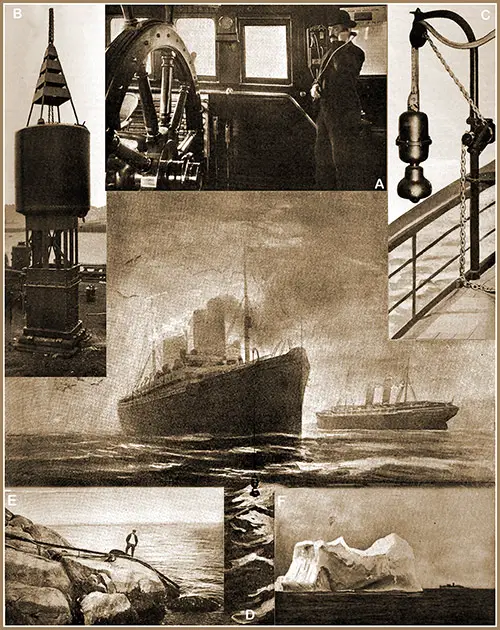Submarine Signaling for Communicating from Shore Stations (1911)

Receiving a Submarine Signal. Scientific American, 4 July 1914. GGA Image ID # 1d30bcddec
- Chart room of the "James S. Whitney" of the Metropolitan Line, running between New York and Boston. This shows the indicator box, by means of which the officer can compare the bell sound on the starboard side with that on the port, by turning a switch, which disconnects one side and connects the other. There are two ear-pieces, so that an operator may have a receiver at each ear, or two operators can share the service, so as to correct their observations. The Fessenden oscillator will be connected to these indicator boxes. The "James S. Whitney" was one of the steamers used In submarine signal experiments conducted for members of the United States Lighthouse Board.
- Submarine bell-buoy for Swakopmund, Southwest Africa.
- Submarine signal apparatus. Outboard gear installed on a lightship. The bell hangs down 25 feet under water.
- Illustration Showing the Position of the Bell Under Water
- Submarine bell cable landing at Chebacco Head, Halifax. Because of the severe storms at this point, a rail had to be used to hold the cable in position. There are now 148 bell stations worldwide, and 1,225 war and mercantile vessels have apparatus for receiving the sound from these bells.
- The United States revenue cutter "Miami" close to berg (off Grand Banks), similar to that which destroyed the "Titanic." The Fessenden oscillator obtained echoes from Icebergs two and a half miles away, the distance determined by a stop-watch. Had the "Titanic" been equipped with hu apparatus capable of ascertaining the presence and distance of the iceberg, she might have been saved.
Government tests have proved submarine signals to be of the greatest value to navigators, which fact has been recognized by the principal steamship lines, practically all of which have now officially adopted the system, and have equipped their ships with receiving apparatus.
Among the transatlantic lines using this system are the Allan Line, American Line, Atlantic Transport Line, Canadian Pacific Co. (Atlantic Service), Cunard Line, French Line, Hamburg America Line, Holland-America Line, North German Lloyd Line, Red Star Line, Royal Mail Steam Packet Co. and White Star Line. More than 600 steamships are now equipped with submarine signal receiving apparatus.
The system comprises two parts: First, the signaling apparatus adapted to produce sounds in the water. This may be at a fixed station, as a buoy or lightship; Second, the receiving apparatus, located on a ship, which enables the navigator to hear the signals and to determine the direction from which they come.
The stationary signaling device consists of a submerged bell of peculiar design adapted to produce sounds of long range under water. The bell is rung by being struck automatically by a clapper, making distinct strokes separated by intervals of silence, after the manner of fire alarm bells, striking and repeating a number which identifies its location. Such bells, in diameter from fifteen to eighteen inches, have a practical range under water of six to twelve miles, and have been heard under favorable circumstances upwards of twenty-five miles.
The sound receiving apparatus, as applied to ships, comprises a pair of microphone transmitters—, which might be called the ears of the vessel—located inside the hull below the water line; the receiving telephones and the direction indicator, the last two of which are placed in the wheel house. The sound of the submarine bell passes from the outer water through the side of the ship into the liquid in the microphone tank, where it affects the microphone in the same way as an ordinary telephone transmitter. Wires, through a battery, to the receiving telephones, connect these microphones.
By holding the telephone to his ear and turning the indicator switch to connect with either the port or starboard microphone, the pilot can hear the sound of the submarine bell as received on either the port or starboard side of the ship. The sound is always heard louder on the side towards the bell. To point the ship exactly at the bell, the pilot swings her head around toward the side on which the sound is louder, until a sudden falling off in the intensity of the sound indicates that the bow is passing across the line of direction.
When the bell is directly ahead, the sounds are equal on both sides. The bearing of the bell can then be taken accurately by the compass, and the vessel’s course laid accordingly. The degree of accuracy with which the bell can be located after a little practice is surprising. Most navigators can do it within one-half a point of the compass.
Presbrey, Frank, " Submarine Signalling," in Presbrey's Information Guide for Transatlantic Travelers, Seventh Edition, New York: Frank Presbrey Co., 1911: P. 82.
